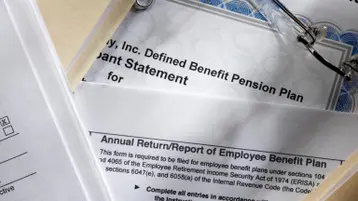
Table of contents
- 1.Question: Does an employee’s FSA contribution limit reset when they join another company?
- 2.Question: What are the contribution limits for FSAs?
- 3.Health FSA contribution
- 4.Dependent care FSA
- 5.Question: What are the limits on employer contributions to health care FSAs?
- 6.Question: Can I make changes to my FSA contributions?
- 7.Acceptable changes
- 8.Unacceptable changes
- 9.Question: Can employees cancel their FSA?
- 10.Question: What happens to unused health FSA amounts?
- 11.Need more answers? Tap into TriNet!
Flexible spending accounts (FSAs) give employees a tax-advantaged way to pay for their health care and dependent care expenses. (While they are similar to health savings accounts in some ways, FSAs and HSAs are not the same.) To make sure these benefits are properly used, the IRS sets annual FSA contribution limits. During open enrollment in health care FSAs or dependent care FSAs, employees must weigh these limits against what they expect to spend on eligible expenses. If they don't contribute enough, they could fall short of funds before the year is up. Contribute too much, and they could lose access to unused funds.
This comprehensive overview walks you through the most common questions and misconceptions about FSA contribution limits. These insights will help you make more informed decisions about your annual contributions.
Question: Does an employee’s FSA contribution limit reset when they join another company?
Answer: Yes. Contribution limits (and FSA) tie to employees’ plans. Consider this example:
- Donna contributes to a flexible spending account through her current employer.
- She leaves that job for another employer.
- Donna decides to contribute to a new FSA with her new employer.
- She can contribute up to the annual contribution limit through her new employer.
Note that employees can contribute to their new employer's FSA plan regardless of how much they contributed through the previous employer.
For example, if an employee contributed $3,200 to a health care FSA with a previous employer, they may have reached their annual limit. If they switch jobs in the same year, they can also contribute up to $3,200 with the new employer.
Question: What are the contribution limits for FSAs?
Answer: Employees elect separate annual contribution amounts for health care or limited purpose flexible spending accounts and dependent care FSAs (DCFSA) up to the annual IRS limits.
| Single or Married, Filing Jointly | Married and Filing Separately |
Health Care / Limited Purpose FSA | $3,050 (2023) | $3,050 (2023) |
Dependent Care FSA | $5,000 (2021, 2022, 2023, and 2024) | $2,500 (2021, 2022, 2023, and 2024) |
Health FSA contribution
For spouses filing jointly, each spouse can elect up to the health care max in the year. In 2024, that would be $3,200 + $3,200 = $6,400 household total.
Dependent care FSA
Total contributions for both the employer and employee cannot exceed the maximum annual contribution limit of $5,000 (2024) for DCFSAs. Any amount exceeding that is taxable income. Additionally, when a married couple files separately, the total combined contribution for DCFSAs cannot exceed $2,500 for each.
Question: What are the limits on employer contributions to health care FSAs?
Answer: Employers can also choose to contribute to employees’ health FSAs and match up to a maximum of $3,200 in 2024.
Since employer contributions are established during setup, employees may elect a lower contribution than their employer. If the employer’s contribution is greater than the employee’s contribution, and the employee contributes more than $500, the employer can only match the lower employee contribution. If the employee contributes less than $500, the employer can contribute up to $500.Employer contribution amounts are set during company plan enrollment and cannot be changed until the plan's year-end.
Let’s consider some examples:
Employee Contribution | Employer Contribution | Combined Amount Applied to FSA |
$1,500 | $1,500 (match) | $3,000 |
$1,000 | $1,500 (not a match; only $1,000 applies) | $2,000 |
$1,000 | $500 (less than employee) | $1,500 |
$300 | $500 (not a match, but acceptable) | $800 |
$0 | $500 | $500 |
Question: Can I make changes to my FSA contributions?
Answer: Only in certain situations.
After initial enrollment, employees and employers can make changes to their FSA contributions in only three cases:
- Before the plan year begins.
- Before a new hire’s effective date.
- Because of a
FSA contribution changes due to a QLE must reflect the nature of the event. For example:
Acceptable changes
If an employee has gone through a qualifying life event and wants to enroll in an FSA, they should contact their benefits administrator. A plan may adopt all, some or none of the QLEs laid out by the IRS. Applicable scenarios include:
- When an employee’s dependent turns 26, they may decrease their FSA contribution to reflect the loss of a dependent.
- Employees who adopt a baby may want to increase coverage to accommodate the new medical expenses.
- If an employee gets married, they may want to increase their elections.
- If an employee’s spouse loses their job, it would be acceptable for the account holder to increase their FSA contribution.
- An employee who changes residence may alter their contributions.
- If an employee, spouse or dependent becomes eligible for Medicare or Medicaid, the employee may reduce or cancel elections.
Unacceptable changes
Employees can't change their contributions on a whim. An example of an event that doesn't qualify for making changes is if an employee wants to reduce their DCFSA contributions after the birth of a child. Though birth is a QLE, the reduction is inconsistent with a QLE.
Question: Can employees cancel their FSA?
Answer: Yes, but only during the renewal period or upon experiencing a QLE.
As an employee, you can only change elections to your FSA during the renewal period or after experiencing a QLE. If you have experienced an applicable qualifying life event, contact your employer's HR department.
Question: What happens to unused health FSA amounts?
Answer: It depends.
According to a recent article on Money.com, workers lose an estimated $3 billion a year in unused FSA contributions.
While FSAs are based on a use-it-or-lose-it foundation, you can maximize your dollars by taking advantage of options or perks your employer or plan might offer, as in:- Your plan's grace period. Schedule doctor appointments to use up your leftover funds.
- Your plan's run-out period. This gives you time to file claims for the previous year's expenses.
- Your plan's rollover offering. If your employer offers it, you can roll over unused FSA funds to the new year. According to HealthCare.gov, the maximum carryover amount for 2023 and 2024 is $610.
Unused funds revert back to the employer.
Need more answers? Tap into TriNet!
Better understanding FSA contribution limits can help you manage your finances wisely and get the most savings from your plans.
Employers seeking to offer a wider range of benefits to increase employee morale and retention can trust TriNet. With vast expertise and powerful solutions, we can help your company build a benefits-rich culture that supports the workforce you value. Reach out today to build better benefits with TriNet.

TriNet Team
Table of contents
- 1.Question: Does an employee’s FSA contribution limit reset when they join another company?
- 2.Question: What are the contribution limits for FSAs?
- 3.Health FSA contribution
- 4.Dependent care FSA
- 5.Question: What are the limits on employer contributions to health care FSAs?
- 6.Question: Can I make changes to my FSA contributions?
- 7.Acceptable changes
- 8.Unacceptable changes
- 9.Question: Can employees cancel their FSA?
- 10.Question: What happens to unused health FSA amounts?
- 11.Need more answers? Tap into TriNet!






